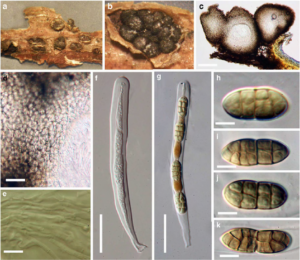Cucurbitaria ephedricola Esfand., Sydowia 1(4–6): 162 (1947)
Facesoffungi number: FoF00934; Fig. 1
Saprobic on wood. Sexual morph: Ascomata 300 – 800 μm diam., immersed to erumpent, grouped, subglobose or flaskshaped and often flattened, with rounded papillate ostiole up to 50 μm diam., black. Peridium 60 – 100 μm wide, composed of 2 – 3 layers of pseudoparenchymatous cells, outer layer comprising of thick-walled, dark brown cells of textura angularis to textura globulosa, inner layer comprising of thin – walled, hyaline to pale brown, flattened cells of textura angularis. Hamathecium composed of 2 μm wide, numerous, hyaline, cellular, branched, septate pseudoparaphyses. Asci 150 – 200 × 13 – 20 (−25) μm (x̄ = 176 × 16 μm, n = 20), 8 – spored, bitunicate, fissitunicate, arising from the base of the inner ascomatal wall, numerous, cylindrical, with a broadly rounded apex with an ocular chamber. Ascospores 20 – 30 (−35) × 10 – 15 μm, ellipsoidal, oblong ovoid, broadly fusiform, often asymmetrical, with obtuse to acute ends, straight or slightly curved, mostly 7 – septate, sometimes 5 – or 6 – or 8 – or 9 – septate, with 1 or 2 longitudinal septa, often distinctly narrower at the median septum, initially colourless or yellowish, later olivaceous brown to dark brown. Asexual morph: undetermined.
Material examined – ITALY, Province of Forlì-Cesena [FC], Strada San Zeno, Galeata, on dead stem, 30 October 2013, E.Camporesi (MFLU 15–1516, reference specimen designate here).

Fig. 1 Cucurbitaria ephedricola (reference specimen) a Appearance of ascomata on the host tissue b Close up of ascoma c Section of ascoma d Peridium cells e Hamathecium of septate, cellular pseudoparaphyses f, g Asci h – k Mature yellowish brown ascospores. Scale bars: c = 200 μm, d = 50 μm, e = 10 μm, f, g = 20 μm, h – k = 5 μm.
